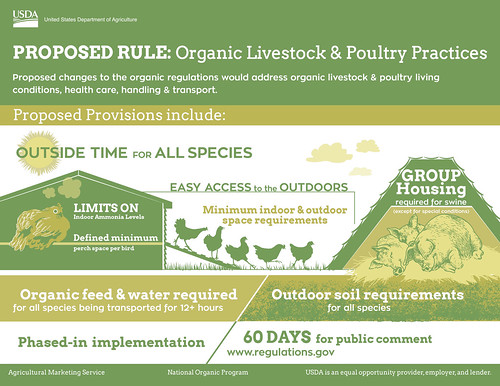
The mission of the National Organic Program, part of USDA’s Agricultural Marketing Service (AMS), is to protect the integrity of USDA organic products in our country and throughout the world. This means clearly defining what it means to be organic and enforcing those rules. Consumers look for and trust the organic seal because they know that USDA stands behind the standards that it represents.
Today, USDA is taking action by announcing that we will soon publish and invite public comment on a proposed rule regarding organic livestock and poultry practices. It’s an important step that will strengthen consumer confidence in the label and ensure that organic agriculture continues to provide economic opportunities for farmers, ranchers, and businesses around the country.
The proposal aims to clarify how organic producers and handlers must treat livestock and poultry to ensure their health and wellbeing throughout life, including transport and slaughter. It would clarify existing USDA organic regulations and add new requirements for organic livestock and poultry living conditions, transport, and slaughter practices. For example, the proposed rule establishes minimum indoor and outdoor space requirements for organic poultry and clarifies that outdoor spaces must be soil-based.
Today’s proposed rule is based on extensive input from the organic community and stakeholders about organic livestock production and handling. It’s also consistent with direction from Congress in the Organic Foods Production Act, which directed the USDA to hold public hearings and develop detailed regulations to guide the implementation of the organic standards for livestock products. The regulations that created the National Organic Program also explained that USDA would develop species-specific guidelines and space requirements for organic animals. Furthermore, the National Organic Standards Board (NOSB), a 15-member advisory committee that represents all sectors of the organic community, has made a number of recommendations that were vital to the development of the rule. The large number of public comments submitted to the NOSB, as well as other communication with the USDA, tells us that most stakeholders strongly support rulemaking in this area.
The total retail market for organic products is now valued at more than $39 billion in the United States. AMS announced on Monday that from 2014 to 2015, the sector grew by 12 percent. USDA has strengthened programs that support organic operations over the past seven years, helping to make organic certification more accessible, attainable, and affordable through a "Sound and Sensible" approach. This initiative includes streamlining the certification process, focusing on enforcement and working with farmers and processors to correct small issues before they become larger ones.
USDA has also established a number of resources to help organics producers find technical and financial resources to help them grow domestically and abroad. The site www.usda.gov/organic creates a one-stop-shop for operators, and USDA has made market and pricing information for approximately 250 organic products available free of charge through USDA's Market News. In 2015, USDA made more than $11.5 million available to assist organic operations with their certification costs.
USDA strongly supports organic agriculture and is committed to establishing a level playing field that protects all organic farms and businesses. Transparency and public participation are vital to USDA’s work in organics. We encourage the organic community, consumers, industry, and other stakeholders to provide comments and feedback on the proposed rule. Here is the Federal Register link: https://www.federalregister.gov/articles/2016/04/13/2016-08023/national-organic-program-organic-livestock-and-poultry-practices
